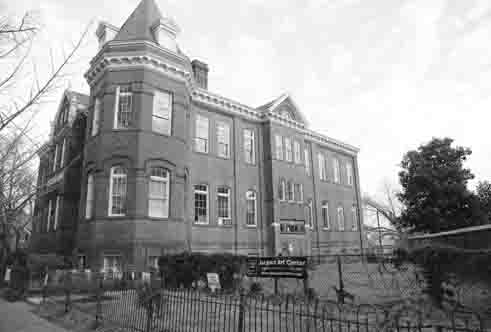Jackson Art Center Draws Lease Extension Until 2018

By Katie PearceCurrent Staff Writer
It looks like the Jackson Art Center can stay put in its Georgetown home for another two years, though questions remain about a more long-term arrangement.
The nonprofit is negotiating with the city to continue occupying the 3050 R St. property until 2018. Its current lease for the historic public school building, which now features 45 high-in-demand artist studios, is set to expire in June 2016.
Jackson Art Center representatives said no deals have been inked yet, but Kenneth Diggs, spokesperson for the D.C. Department of General Services, confirmed that his agency is “currently extending the lease for two years” for the city-owned property.
This being the art center’s second short-term lease extension, members are looking for a more stable arrangement for the future. They’ve mounted an online petition for this cause, and they’re also drumming up support from Georgetown community groups in hopes of reaching city higher-ups.
“Everybody there wants to stay in the space, certainly,” said potter Eileen Egan, who has rented a studio in the Jackson Art Center since 2011, after a couple of years on a waiting list. Not only is the 1890 school building “a great place to work quietly, [with] a lot of light,” but it’s also a rare resource for the city, she said. “There are so few art studios here.”
Egan added that many of Jackson’s members live nearby — she personally can bike to her studio, while quite a few members live close enough to walk there.
Ideally, the art center would like to sign a 20-year lease with the city, said Simma Liebman, the group’s president. She said that’s the typical timeframe for the city’s leases on public buildings.
Diggs of the General Services Department wrote in an email that his agency is “assessing that option.”
But the prospect might be idealistic, given the property’s high value (it was assessed at over $6.64 million this year) and previous interest from developers.
In 2012, Jackson’s negotiations to extend its lease for five years were suspended due to a developer’s inquiry into purchasing the building, potentially to build condominiums. The city ultimately allowed the center to extend its lease for three more years, until 2016.
It’s also relevant that the art center sits immediately next door to the Hurt Home, a former public building the city sold for $7.75 million a couple of years ago to become luxury condos. According to Diggs, the city hasn’t heard any development proposals for the Jackson site recently and has no current plans to open up bids for it.
In order to sell the site, the city would need to declare it “surplus” through a D.C. Council process, and charter schools would get the first chance to acquire it.
The Jackson School closed around 1970 due to declining elementary school enrollment in the neighborhood, and artists began leasing the space in the 1980s. Those artists and the Corcoran School of Art shared the site until 1998, at which point the Corcoran found classroom space elsewhere and the Jackson Art Center became the building’s sole tenant.
Currently, the rent and membership fees from the Jackson Art Center cover the lease payment to the city — which Diggs said is just over $12,850 per month — in addition to administrative costs. In her email, Liebman also said the art center “is responsible for all maintenance, repair and renovation of the historic building, funds for which come from rent credits provided by the city.”
The center’s pursuit of a longer-term lease has won support recently from both the Georgetown advisory neighborhood commission and the Citizens Association of Georgetown.
In a recent letter to city officials, neighborhood commissioners characterized Jackson as “a significant fixture in the community for over 30 years, [and] home for more than 40 artists who have given back to the community through art workshops, community art programs in local schools, lectures, and workshops in the local senior center.”
The letter urged the city to “renew a long-term lease with Jackson” or make “equivalent arrangements” to keep the Jackson Art Center in place there.
This article appears in the April 1 issue of The Georgetown Current newspaper.
